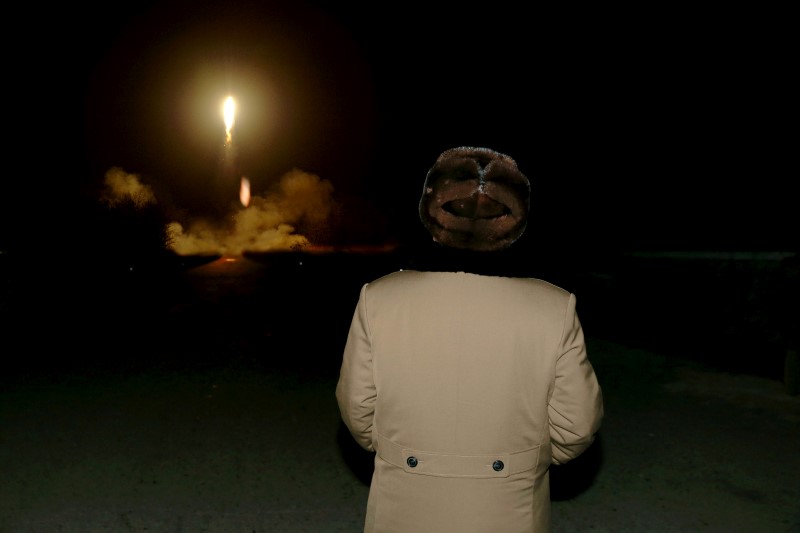By Jack Kim
SEOUL (Reuters) - Images in March of a smiling Kim Jong Un inspecting a silver sphere, purported to be a miniaturised nuclear warhead but likened in the media to a disco ball, burnished the North Korean leader's international image as deluded and reckless.
But on Wednesday, the man Hollywood and others love to mock proved sceptics wrong with what looks like the successful launch of a ballistic missile that reached an altitude of 1,000 km and got over half way to Japan's main island of Honshu.
Experts said the launch, which came after five failed tests including one earlier on Wednesday, marked progress in North Korea's weapons programme, and underlined Kim's steely determination as well as his patience with scientists involved.
The quick succession of flight tests of the Musudan missile, which began in April, also resembles methods used in the early stages of missile development by super powers decades ago, when sophisticated simulation equipment was not available to substitute actual tests.
"This rate of attempts is not too different from what the U.S. was doing in the Cold War," Jonathan McDowell of the Harvard Smithsonian Center for Astrophysics said. "It's of course very different from what the USA is doing these days.
"It may reflect the fact that North Korea has less capabilities in computer analysis, so it's easier for them to just launch another missile than to run a computer simulation."
Reclusive North Korea's state propaganda has painted Kim as a demanding but generous and understanding leader willing to forgive the failures of its scientists.
That contrasts with his reputation overseas as ruthless and impulsive, after he executed his own uncle, replaced his defence chief five times and defied the world with two nuclear tests.
"Humans grow by eating food and science flourishes amidst failures," North Korea's state-run newspaper Rodong Sinmun quoted Kim as telling scientists who knelt before him after a failed rocket launch in April 2012.
The dispatch was issued after an eventual successful launch in December that year.
The comments were echoed in a later state publication that described Kim patiently encouraging scientists distraught by failure.
"On receiving the report of the failure, Kim Jong Un said that failure was commonplace," a 2012 book summarising a year of the young leader's activities said, referring to a failed long-range rocket launch earlier that year.
"What was important was to find out the cause of the failure as soon as possible and make a successful launch," it quoted Kim as saying.
PEOPLE "NOT SHOT" FOR FAILURES
Michael Madden, an expert on political leadership in the North who has contributed to the Washington-based 38 North think-tank, said rumours of technicians behind failures being shot or purged were "nonsense".
"One thing to note is that people don't get shot behind failures," said Madden, who edits North Korea Leadership Watch. "They get shot because they lie in their reporting or refuse to accept responsibility."
Wednesday's second launch ended a recent run of unsuccessful attempts to test the Musudan missile, which is designed to fly more than 3,000 km (1,800 miles) and could theoretically reach all of Japan and the U.S. territory of Guam.
While failure is potentially embarrassing for Kim, the failed Musudan tests have not been reported in the North's tightly controlled state media, meaning that most North Koreans are in the dark about the programme.
"There's no great political risk to Kim Jong Un's status or reputation, because only a tiny percentage of the population even knows about the tests," Madden said.
Instead, Wednesday's second missile launch in a day and the failures which preceded it may in fact demonstrate Kim's determination to make the technology work, said Yang Uk, a senior researcher at the Korea Defense and Security Forum.
"They must have been working extremely hard and to a given time frame in order to make it work," said Yang, who is also a policy adviser to the South Korean military.
Like the rest of North Korea's opaque leadership, the state's nuclear and missile programmes are shrouded in secrecy, and deception and misinformation have long been an important part of propaganda aimed at maximizing the benefit for leaders.
It boasted in March of having successfully tested an engine for an intercontinental ballistic missile (ICBM) and mastered the re-entry technology for a warhead to fit on such a missile, assertions discredited by South Korea and the United States.
Experts said the more likely course of weapons development for the North was to perfect a shorter-range missile that can mount and deliver a nuclear warhead, which would pose a direct threat to the United States with the capability to hit Guam.
Jeffrey Lewis, of the California-based Middlebury Institute of International Studies, said that with continued testing, the North will eventually develop a reliable Musudan that can threaten the United States.

"Failures are a part of testing. The North Koreans will, sooner or later, fix the problems with the Musudan."